In order to shift gears, an automatic transmission uses a series of clutches, valves and gears, which are actuated by pressurized hydraulic fluid (aka transmission fluid). As you drive, heat is generated by these moving parts. If you do a lot of “enthusiastic” driving, or you regularly tow heavy loads, a lot more heat is generated, which can cause internal wear and tear and eventually transmission problems.
What Transmission Do I Have?

In This Guide
- How Does a Transmission Cooler Work?
- What Kind Do I Need?
- 3 Types of Transmission Coolers
- Gross Vehicle Weight Rating (GVWR)
- 3 Best Transmission Cooler Brands
- Hayden Coolers
- Transmission Coolers With Fans
- How to Install an External Cooler
A transmission cooler can help extend the life of your transmission by reducing this heat and keeping the fluid cool. This guide will go into detail about the types of coolers, how to choose one and what the 3 best transmission cooler brands are.
How Does a Transmission Cooler Work?
Just like motor oil, automatic transmission fluid (ATF) absorbs the heat produced by moving internal parts. This heat gets released as the transmission fluid passes through a cooling chamber at the bottom of the radiator. Under normal conditions, this would sufficiently cool the ATF before it gets recirculated back into the transmission.
However, if you add more strain to the gearbox, the components have to work harder, which creates more heat than the stock transmission cooler is designed to handle. This causes the transmission fluid to break down, reducing its ability to perform smooth gear changes.
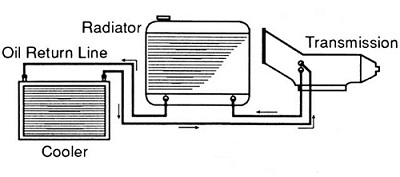
A typical automatic transmission operates at 175 degrees Fahrenheit. This is what can happen as the temperature increases:
- 220-240 F – Varnish forms on internal components
- 240-260 F – Transmission seals begin to harden
- 260-295 F – Clutch plates start to slip
- 295-315 F – Seals and clutches burn-out
- 315+ F – Call a tow truck
To prevent this from happening, an auxiliary transmission cooler can be installed. It acts like a mini radiator, cooling the ATF before it returns to the transmission. This won’t increase your towing capacity or performance. But it will help prevent damage during extreme use, which will ultimately extend the life of your transmission.
What Kind Do I Need?
They come in many shapes and sizes, but a larger cooler doesn’t necessarily cool better than a smaller unit. It all has to do with their cooling efficiency (we’ll discuss that in a minute) and your vehicle’s gross vehicle weight rating (GVWR), which is a measure of a vehicle’s payload capacity.
Each transmission cooler is rated for different GVWR’s, which ensures it will perform correctly for the intended application (we’ll cover that too). Lastly, where you actually place the cooler in your vehicle will affect its performance, so you may have to choose a higher efficiency unit if space is limited.
3 Types of Transmission Coolers
The 3 most common kinds of coolers are: tube and fin, plate and fin and stacked plate. Each offers a different combination of effectiveness and durability. Some coolers also come with built-in fans that provide additional cooling ability. Almost all coolers for automatic transmissions are made from aluminum which is good at dissipating heat.
1) Tube and Fin Coolers
Ideal for older vehicles/occasional towing
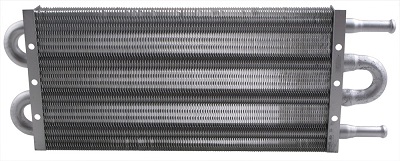
The most common type of transmission cooler is the tube and fin. Hot transmission fluid is forced through an aluminum tube that winds back and forth in an ‘S’ pattern through the assembly.
Inside the tube is a corkscrew-like device known as a turbulator. As the fluid travels through the tube, it swirls around and transfers heat out of the tube to the aluminum fins surrounding it. Since aluminum conducts heat, the fins are able to draw the heat out of the transmission fluid, and the air flowing through the assembly takes the heat away as it cools the fins.
Tube and fin coolers are the most affordable option, but they’re often the least efficient type, due to their rather large size and bulky design.
- Inexpensive
- Least efficient
2) Plate and Fin Coolers
Ideal for modern performance/tow vehicles
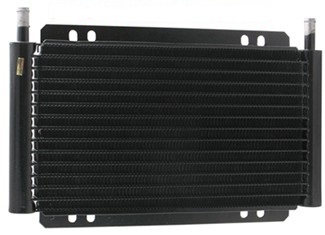
Plate and fin transmission coolers push hot ATF through small aluminum plates, which agitates the fluid much better than the turbulator inside the tube and fin type. This agitation causes the transmission fluid to release heat at a faster rate. And like a radiator, the heat gets transferred to a tight web of aluminum fins, where it’s dissipated by air flowing through the unit.
They are more compact than a tube and fin cooler. It’s also less likely to be damaged by road debris. And it can remove more heat from the transmission fluid, making it a much more efficient choice.
- More efficient
- More expensive
- Smaller and more durable
3) Stacked Plate Coolers
Ideal for extreme towing / off-roading / racing applications
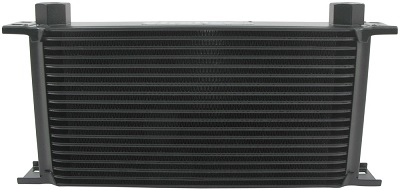
Similar to a plate and fin transmission cooler, stacked plate transmission coolers force the hot ATF through a series of plates, and the heat is evacuated as air flows through the aluminum fins. Except with this design, more air is able to flow through the assembly, resulting in much faster cooling. Stacked plate transmission coolers also use AN fittings, which allows them to be quickly installed or removed.
- Most efficient
- Most expensive
- Smaller & more durable
Gross Vehicle Weight Rating (GVWR)
To help you choose the right transmission cooler for your application, manufacturers rate each one according to GVWR. The Gross Vehicle Weight Rating is the maximum amount of weight (including the weight of the vehicle itself, fluids, passengers, and cargo) that a vehicle is designed to handle (this does not include towing capacity) and can range from 10,000 to 30,000+ pounds.
The higher the GVWR, the more transmission fluid, and consequently, cooling capacity, the vehicle will need. You can find your vehicle’s GVWR in the owner’s manual, or on the “MFG by” label inside the driver’s door jamb. You may also use the following table as a reference:
| Vehicle | Recommended GVWR |
|---|---|
| Small Compact Cars - No Towing | 10,000 to 16,000 lbs |
| Pickup Trucks & SUVs - Towing Up to 7,500 lbs | 22,000 to 26,000 lbs |
| Mid-size cars & Light Towing | 14,000 to 18,000 lbs |
| Heavy Duty Trucks & Motor Homes - Towing Up to 10,000 lbs | 22,000 to 30,000 lbs |
| Mid-size Trucks & Full Size Cars - Towing Up to 5,000 lbs | 18,000 to 24,000 lbs |
| Super Duty Trucks & Large Motor Homes | 28,000+ lbs |
3 Best Transmission Cooler Brands
1) B&M Coolers
 From the makers of the famous B&M Shifter, comes a line of performance coolers that are designed to provide maximum cooling, no matter how hard you drive.
From the makers of the famous B&M Shifter, comes a line of performance coolers that are designed to provide maximum cooling, no matter how hard you drive.
These plate and fin, and stacked plate B&M transmission coolers are available in a wide range of specs, sizes, and finishes. And to keep your gearbox cool on Track Days, they offer performance models with thermal switch controlled 12V electric fans.
See what others have to say about B&M transmission coolers on Amazon
| Image | Model | GVWR (lbs) | Size | Price | Rating |
|---|---|---|---|---|---|
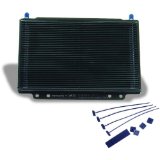 | B&M 70268 SuperCooler | 19,000 | 11" x 7 1/4" x 3/4" | $ | 4.6 |
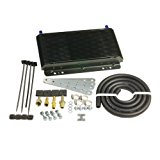 | B&M 70255 SuperCooler | 16,000 | 11" x 5 3/4" x 3/4" | $ | 4.6 |
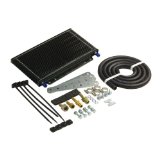 | B&M 70264 SuperCooler | 24,000 | 11" x 5 3/4" x 1 1/2" | $$ | 4.6 |
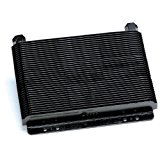 | B&M 70266 SuperCooler | 28,000 | 11" x 8" x 1 1/2" | $$ | 4.3 |
2) Hayden Coolers
 Texas-based Hayden Automotive has been manufacturing automotive cooling products for over 45 years. Many of their products are used by car manufacturers as original equipment, so their quality standards are extremely high. They make tube and fin, plate and fin, and heavy duty transmission coolers for everything from subcompacts, to motorhomes with a GVWR of up to 22,000 lbs. Features include patented turbulator designs, ultrasonic soldering, and powder coated finishes (to resist corrosion). Plus, they even make a remote controlled electric fan for near-instant transmission fluid cooling.
Texas-based Hayden Automotive has been manufacturing automotive cooling products for over 45 years. Many of their products are used by car manufacturers as original equipment, so their quality standards are extremely high. They make tube and fin, plate and fin, and heavy duty transmission coolers for everything from subcompacts, to motorhomes with a GVWR of up to 22,000 lbs. Features include patented turbulator designs, ultrasonic soldering, and powder coated finishes (to resist corrosion). Plus, they even make a remote controlled electric fan for near-instant transmission fluid cooling.
See what others have to say about Hayden coolers on Amazon
| Image | Model | GVWR (lbs) | Size | Price | Rating |
|---|---|---|---|---|---|
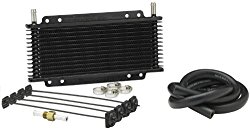 | Hayden 676 Rapid-Cool Plate and Fin | 18,000 | 3/4" x 11" x 6" | $ | 4.7 |
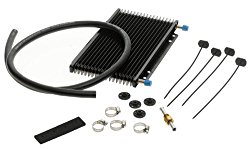 | Hayden 677 Rapid-Cool Plate and Fin | 20,000 | 3/4" x 11" x 7-1/2" | $ | 4.4 |
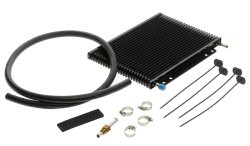 | Hayden 678 Rapid-Cool Plate and Fin | 24,000 | 3/4" x 11" x 9-1/2" | $ | 4.6 |
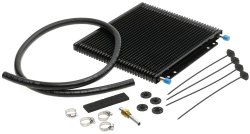 | Hayden 679 Rapid-Cool Plate and Fin | 30,000 | 3/4" x 11" x 11-5/8" | $ | 4.9 |
3) Derale Coolers
 Derale transmission coolers are made by a company called CP Auto Products, which helped to found the now famous SEMA (Speciality Equipment Manufactures Association) back in 1963. Their high quality coolers are Made in the USA, and can be found as original equipment in many new cars and trucks. They’re available in tube and fin, plate and fin, stacked plate, and remote operated fan systems for extreme use and performance applications.
Derale transmission coolers are made by a company called CP Auto Products, which helped to found the now famous SEMA (Speciality Equipment Manufactures Association) back in 1963. Their high quality coolers are Made in the USA, and can be found as original equipment in many new cars and trucks. They’re available in tube and fin, plate and fin, stacked plate, and remote operated fan systems for extreme use and performance applications.
See what others have to say about Derale coolers on Amazon
| Image | Model | GVWR (lbs) | Size | Price | Rating |
|---|---|---|---|---|---|
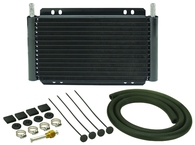 | Derale 13502 Series 8000 Plate and Fin | 22,500 | 5" x 13" x 2" | $ | 4.7 |
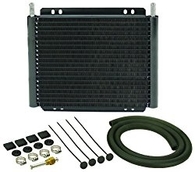 | Derale 13503 Series 8000 Plate and Fin | 20,500 | 9 3/4" x 11" x 3/4" | $ | 4.4 |
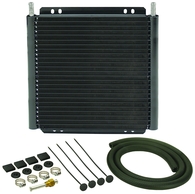 | Derale 13504 Series 8000 Plate and Fin | 22,500 | 11-1/4" x 11" x 3/4" | $ | 4.4 |
Transmission Coolers With Fans
Since transmission coolers function in the same way as a radiator, they can benefit from the additional airflow provided by an electric fan. Having one with a fan, allows you to switch it on, and provide immediate, maximum cooling for the ATF. This type of cooler does require a fair amount of room to install, but it can help prevent your transmission from failing during heavy use.
| Image | Model | Size | Price | Rating |
|---|---|---|---|---|
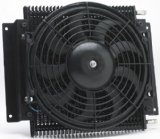 | Hayden 526 Remote Cooler With Fan | 13 .8" x 11" x 4" | $$$ | 4 |
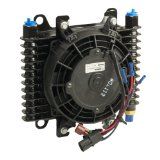 | B&M 70298 Hi-Tek SuperCooler Oil Cooler with Fan | 10" x 7.5" x 4" | $$$$ | 4.2 |
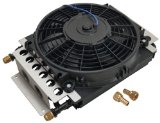 | Derale 15800 Electra-Cool Remote Cooler With Fan | 19.2" x 14.5" x 6.5" | $$$ | 4.2 |
How to Install an External Cooler
If you plan to install a transmission cooler yourself, then you’ll need to find a place to put it. Like your car’s radiator, a cooler relies on airflow to dissipate the heat. So it needs to be mounted someplace that allows it to get as much air as possible.
Most manufacturers recommend that you place the transmission cooler in front of the A/C condenser, on the front side of the radiator. This will allow maximum airflow, and the best cooling efficiency. You can mount it elsewhere, particularly if it is equipped with an electric fan. But this will require extra effort to route the transmission lines properly.
Once you’ve chosen the mounting point, locate the inlet and outlet transmission lines at the bottom of the radiator. The ATF still has to circulate through the stock cooler inside the radiator, so the return side on the radiator is where you’ll connect the adapters that came with the kit.
Next, run a line from the radiator outlet to the inlet side of the transmission cooler, and connect (using the hoses, adapters, and clamps supplied with the cooler) the outlet side to the return line that you removed from the radiator. Now start the vehicle and check for leaks.
What Transmission Do I Have?

Important things to remember:
- The cooler must be mounted at least 1/2 inch away from the A/C condenser/radiator
- The hoses and cooler must be secured away from any moving parts
- Always use quality hoses, clamps and hardware
- Check for leaks and hose / cooler condition periodically
What to Read Next
- How to Change Transmission Fluid
- Types of Transmissions
- What is a Transmission Flush?
- What Transmission Do I Have?
Over to You
We’re interested to know – what type of cooler are you leaning towards and why are you looking to get one for your vehicle? Let other readers know by leaving a comment below!

I’m interested to know why fitting is recommended after the radiator in this article. 4runnner / Hilux Surf in particular generates a lot of heat from the transmission under hard use, and the heating effect of the radiator cooler on the engine coolant just before it re-enters the engine, is known to contribute to engine overheating. Placing it in line before the radiator helps prevent this. The only argument I’ve heard for fitting after the radiator, is for extreme cold weather setups, where the ATF is said to help warm coolant on startup and get engine up to temp quicker. Genuinely interested to hear different viewpoints on this.
My 2009 Hyundai Sonata shows Check Engine due to Code P0741 in summer only. The engine and transmission do not always lock up at highway speed in warm weather. Would a transmission cooler prevent this from happening?
Question if i installing the fan type tranny cooler can I take off water pump fan is there Enough volume of air to cool the motor also
Is it harmful if you mount a cooler that’s rated at a larger GVWR than what your car is rated for? Not by much, but some.
I have a Isuzu tooper and the transmission is getting hot I need to find the sensor where is it at
Is there a reason the transmission cooler lines run though the radiator? Can you run the lines directly from the trans to the cooler?
– yes, if the transmission cooler is of high enough cooling capacity, and has some sort of thermally switched fan, to ensure cooling continues under hard use/low speed conditions.
The built in radiator ATF cooler will continue to cool under these conditions,as the radiator fan continues to drive airflow, but a standalone ATF cooler without a fan would lose cooling efficiency. For extreme use cases this is the most reliable setup, as eliminates chance of radiator failure allowing coolant and ATF to mix, killing the transmission.
yes sir,,,, get that trans fluid out of that heater